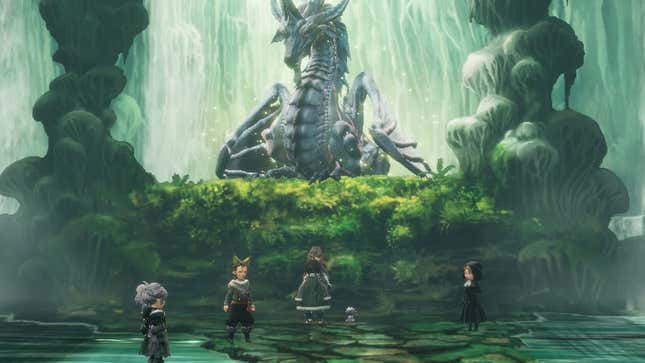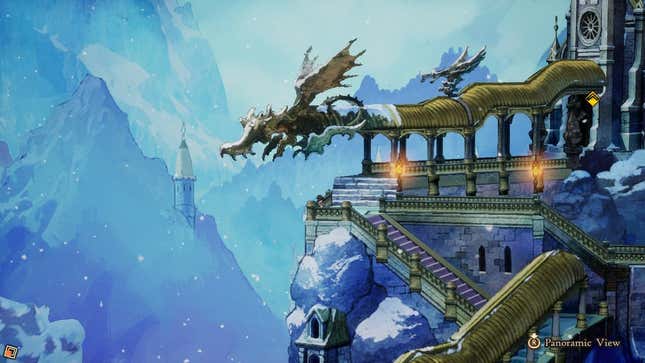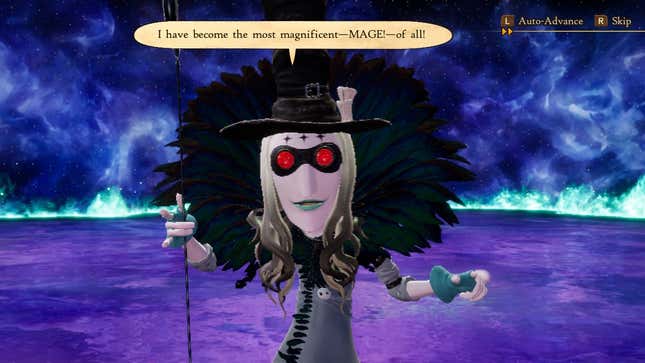
Bravely Default 2 is a trip, man. Going in, I thought I knew exactly what this game was, and it turns out I pretty much did—except for all of the tiny moments that occasionally delight, and just as occasionally elicit big, heaving sighs. Every time the familiar old-school JRPG wins me over it follows that up by kicking my ass in some pretty obnoxious ways. I want Bravely Default 2 to be my before-bedtime chillout ritual, but obtuse boss fights, dungeon filler, and joyless story scenes have messed up more than a few nights.
I’ve been living with this game, out on Switch February 26, for the last month. It’s been with me on the couch while I watched Premier League champions Liverpool lose game after game, on the kitchen counter when I made dinner, and in the nursery while getting my kid ready for bed. I’ve put in about 40 hours so far, not including starting over after dying, and while my full review will follow later, I can say for now that there’s a lot to love and hate in the latest ode to classic Final Fantasy games.

Here’s a tale of two Bravely Default IIs. In the first I’m wandering around whimsical medieval villages helping random townspeople with their problems in exchange for resources and equipment to help me on my journey. Eventually I make my way into a dungeon—perhaps a windy set of desert ruins or a glistening icy cavern—kill a bunch of enemies, level up my party, learn cool new skills, and then use them to demolish a boss at the end of it all. It’s a familiar pattern, one of JRPGs have been following for decades now, but also one Claytech Works, the newly formed studio that made the game, nails more cleanly than most.
In the second I find a dungeon save spot thinking it’s the end, only to realize I’m not even a third of the way through it. Battles out in the field with spongy enemies pile up one after the other, failing to reward me with as much XP and gold as I would like, while also soaking up the majority of my healing items. I finally make it limping to the boss after a grueling gauntlet padded with dead ends and treasure chests, whose contents border on insulting, only to find my combat strategy that had previously been working is failing miserably. Knocking my head against the wall trying to unlock the secret to beating the big bad I end up spending more time dying and restarting than I’d previously spent traversing the entire dungeon. Bleh.

The game has some nice quality of life features to help minimize this pain. It autosaves every time you enter a new room, which is a godsend. You can hit X on the menu screen to auto-heal your party using magic in between battles. A forage command in the Freelancer job class lets you pluck random items out of thin air, letting you find a much needed phoenix down or ether after a few tries during battle no matter where you are. There’s also the sailing mini-game which creates a micro-adventure log while the game is in rest mode, netting you extra gold, stat boosts, and bonus JP orbs while you’re not playing, which is another nice feature to try to cut down on the grind.
But the game is hard, occasionally ridiculously so, and it’s rarely something you can just grind your way out of. Instead, you have to approach the most recent difficulty spike, either an unusually tough enemy in standard battles, or more often a super tough boss fight, by completely changing up your strategy, meticulously tinkering with your party’s jobs, armor, and ability loadouts to maximize their effectiveness and survivability. Early on this was a fun new challenge that made me think more deeply about Bravely Default II’s wonderfully customizable job system.
But in the back half of the game it forced me to play party builds I wasn’t interested in simply to limp across the finish line after a marathon fight. A few battles are exceedingly cheap, with bosses that counter when you use heals, buffs, or even just make use of the game’s unique turn-banking brave and default system. This would have been less of a headache if Bravely Default II did a better job of signposting these consequences during battle, but often in these tougher, later fights I was at a loss as to what was happening half the time, or why, in-between my characters’ turns. This made coming up with a winning solution that much more bewildering, even if the creative job classes—you can play as a godman pictomancer who wrecks enemies with paint—offered a wealth of different ways to approach each encounter.
All of this is to say that while I’ve had a wonderful time adventuring in Bravely Default II’s familiar but streamlined JRPG world, it is not for the faint of heart, or those who aren’t ready to get deep into the details of stat math and build synergies. And even then there are more than a few rough edges to catch a frustrating splinter on while playing, something I also literally did when grinding battles in between doing demolition on my kitchen pantry. Also the game’s sidequests are mostly terrible, but more on that when my full review hits.
Clarification: removed a reference to random encounters to make it more clear that battles are initiated by running into enemies visible on the map.